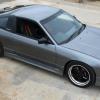Trick For More Horses. Need Clarification
Announcements
-
Similar Content
-
Latest Posts
-
Ah yes, but the part in my hand was actually painted and fitted by me! I knew any front lip was likely to be sacrificial but I've had to fix it twice already... by the time I buy a fibreglass fixing kit, sort out sandpaper blocks, buy some fibreglass filler, body bog, spend the time and effort for a 'Greg' result... a new one being $290 seems like it's the better way to go and spray that with bedliner/raptor coat and we're all pretty again.. Would have preferred it last more than a month though. Them's the breaks I suppose.
-
I find it funny that the USA is finding out all this really really weird stuff, and people from the USA are coming here treating it like gospel, yet, all the info on solving those issues is here on these forums for the last 15 odd years... Also, I know how much heat it takes to ignite the hood lining of an R33 skyline. I worked it out myself... It also took a LOT of time, and heat for it to do it... Big single, and I needed to drive the car, so retarded the timing off to "protect it". Yeah, that was a bad move for cruising on a freeway with only 15 degrees of timing on it. That was a lesson I learned around 2009. So that's over 15 odd years ago. Aligning water and oil, that's identical for any turbo engine, it's not Japanese specific. If a shop doesn't know how to make sure the core is rotated the right way, then they shouldn't be touching any turbo engine. That's not a matter of "We haven't had Skylines for that long here"...
-
Sounds like it is rotational in the driveline. CV? Tailshaft CB? Also.....didn't you just pay to have that bit painted and put on the car?
-
Yeah, when I dialled my idle down, given how much time I spent idling at the lights in traffic on my daily commute, the effect on overall fuel consumption was absolutely noticeable.
-
By Dose Pipe Sutututu · Posted
Emissions, fuel consumption, heat, noise, etc. most likely.
-







Recommended Posts